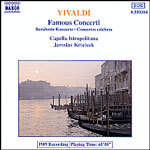
Vivaldi: Famous Concertos
 $25.00
Out of Stock
$25.00
Out of Stock6+ weeks add to cart
ANTIONIO VIVALDI
Vivaldi: Famous Concertos
Capella Istropolitana / Jaroslav Krcek (conductor)
[ Naxos / CD ]
Release Date: Saturday 1 May 2004
This item is currently out of stock. It may take 6 or more weeks to obtain from when you place your order as this is a specialist product.
"This is a recommendable disc from which to set out to explore the Vivaldi concertos"
- Penguin Guide
Once virtually forgotten, Antonio Vivaldi now enjoys a reputation that equals the international fame he enjoyed in his heyday. Born in Venice in 1678, the son of a barber who was himself to win distinction as a violinist in the service of the great Gabrielis and Monteverdi at the basilica of San Marco, he studied for the priesthood and was ordained in 1703. At the same time he established himself as a violinist of remarkable ability. A later visitor to Venice described his playing in the opera-house in 1715, his use of high positions so that his fingers almost touched the bridge of the violin, leaving little room for the bow, and his contrapuntal cadenza, a fugue played at great speed. The experience, the observer added, was too artificial to be enjoyable. Nevertheless Vivaldi was among the most famous virtuosi of the day, as well as being a prolific composer of music that won wide favour at home and abroad and exercised a far-reaching influence on the music of others.
For much of his life Vivaldi was intermittently associated with the Ospedale della Pietà, one of the four famous foundations in Venice for the education of orphan, illegitimate or indigent girls, a select group of whom were trained as musicians. Venice attracted, then as now, many foreign tourists, and the Pietà, and its music long remained a centre of cultural pilgrimage. In 1703, the year of his ordination, Vivaldi, known as il prete rosso, the red priest, from the inherited colour of his hair, was appointed violin-master of the pupils of the Pietà. The position was subject to annual renewal by the board of governors, whose voting was not invariably in Vivaldi's favour, particularly as his reputation and consequent obligations outside the orphanage increased. In 1709 he briefly left the Pietà, to be reinstated in 1711. In 1716 he was again removed, to be given, a month later, the title Maestro de' Concerti, director of instrumental music. A year later he left the Pietà, for a period of three years spent in Mantua as Maestro di Cappella da Camera to Prince Philip of Hesse-Darmstadt, the German nobleman appointed by the Emperor in Vienna to govern the city.
By 1720 Vivaldi was again in Venice and in 1723 the relationship with the Piet8. was resumed, apparently on a less formal basis. Vivaldi was commissioned to write two new concertos a month, and to rehearse and direct the performance of some of them. The arrangement allowed him to travel and he spent some time in Rome, and indirectly sought possible appointment in Paris through dedicating compositions to Louis XV, although there was no practical result. Vienna seemed to offer more, with the good will of Charles VI, whose inopportune death, when Vivaldi attempted in old age to find employment there, must have proved a very considerable disappointment.
Tracks:
Concerto in F Major for Oboe, Strings and Basso Continuo, No.2, RV 455
Concerto in G Minor for Violin, Strings and Basso Continuo, Op. 12 No.1, RV 317
Concerto in D Major for Guitar and Strings (Lute Concerto RV 93)
Concerto in B Flat Major for Oboe, Violin, Strings and Basso Continuo, RV 548
Concerto in D Minor for Trumpet and Strings (transcribed by Jean Thilde)
Concerto in G Minor for Two Celli, Strings and Basso Continuo, RV 531
